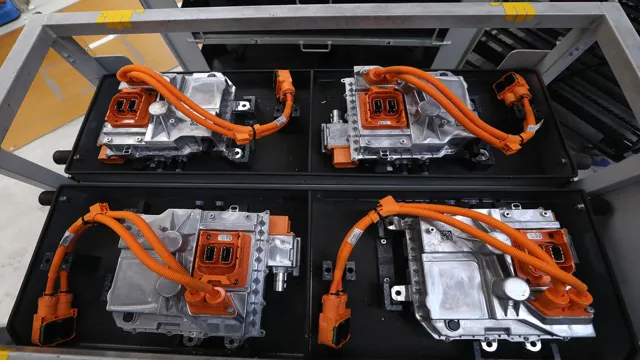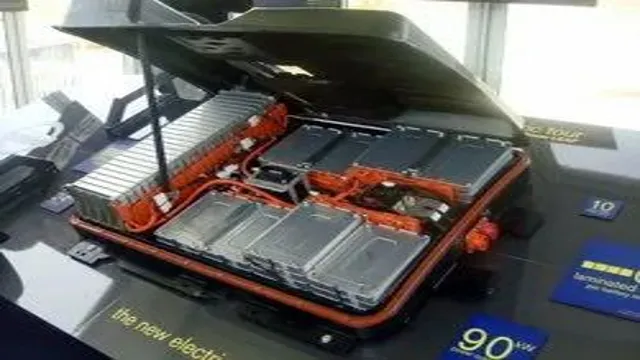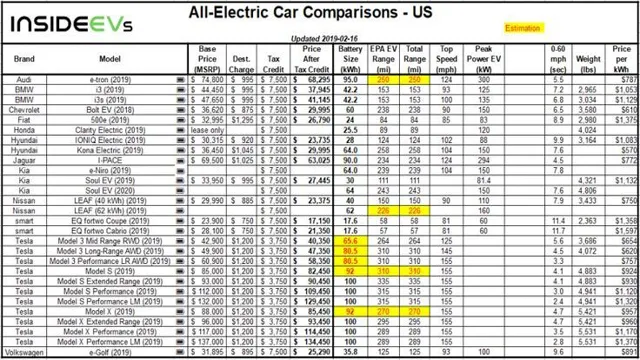The Dark Truth Behind Electric Cars: Uncovering the Carbon Footprint of Battery Production
Electric cars have become increasingly popular in recent years as more people are becoming environmentally conscious and looking to reduce their carbon footprint. However, a common concern regarding electric cars is the carbon footprint associated with the production and disposal of their batteries. While the cars themselves produce zero emissions during operation, the batteries have a significant environmental impact.
So, what is the carbon footprint of electric car batteries? Studies show that the production of the battery accounts for the largest portion of its carbon footprint. The production process involves mining, refining, and manufacturing of materials such as lithium, cobalt, and nickel, which are essential components of the battery. These processes require large amounts of energy, which are predominantly generated from fossil fuels, resulting in significant greenhouse gas emissions.
Additionally, the end-of-life disposal of the battery also has a negative environmental impact. Batteries can be recycled, but the process is energy-intensive and limited. If batteries end up in landfills, hazardous substances can leak into the soil and groundwater.
Despite these concerns, it’s important to note that the carbon footprint of electric cars is still significantly lower than that of traditional gasoline-powered cars. Electric cars emit less greenhouse gases during operation and are more efficient, requiring less energy to travel the same distance. In conclusion, while electric car batteries do have a carbon footprint, they’re still a much greener option when compared to gasoline-powered cars.
Minimizing the battery’s carbon footprint can be achieved through improved battery production methods, increased battery recycling efforts, and advancements in battery technology. The goal, ultimately, is to make electric cars as sustainable and eco-friendly as possible.
What is a Carbon Footprint?
When it comes to producing batteries for electric cars, one major environmental concern is the carbon footprint left behind. But what is a carbon footprint? Essentially, it is the amount of greenhouse gases – mainly carbon dioxide – that are produced through human activities, such as manufacturing and transportation. When it comes to producing batteries for electric cars, the carbon footprint can be quite high due to the amount of energy and resources required.
This includes the mining of materials such as lithium and cobalt, transportation of these materials to the production facilities, the actual manufacturing process, and subsequent transportation of the batteries to the car manufacturers. However, it’s important to note that while the carbon footprint may be high during this initial phase, electric cars still have a much lower carbon footprint overall compared to gas-powered vehicles, thanks to the fact that they emit no tailpipe emissions during use.
Explanation and Calculation
A carbon footprint is the total amount of greenhouse gas emissions that are produced by an individual, organization, event, or product. These emissions are usually measured in units of carbon dioxide equivalents (CO2e). Carbon footprint calculations take into account all stages of a product’s lifecycle, from raw material extraction and manufacturing, to transportation, use, and disposal.
Every activity we engage in contributes to our carbon footprint, from the food we eat and the energy we consume, to the transportation we use and the products we buy. Some activities have a higher carbon footprint than others, such as air travel and meat consumption. By calculating our individual carbon footprint, we can gain a better understanding of our environmental impact and take steps to reduce it.
To calculate our carbon footprint, we need to consider various factors such as our energy use at home, our transportation methods, and our dietary choices. There are many online calculators available that can help us estimate our carbon footprint based on these factors. By reducing our energy consumption, using public transportation, and choosing plant-based diets, we can significantly reduce our carbon footprint and contribute to a more sustainable future.
In summary, a carbon footprint is a measure of our impact on the environment in terms of greenhouse gas emissions. By understanding and calculating our carbon footprints, we can take steps to reduce our environmental impact and preserve the planet for future generations.
How Are Electric Car Batteries Produced?
As electric cars become more mainstream, there is growing concern over their carbon footprint. The production of electric car batteries is a critical issue when it comes to measuring the overall carbon footprint of these vehicles. Most electric car batteries are made using lithium-ion technology which requires a significant amount of energy and resources to produce.
The production process involves mining the raw materials, processing them, and assembling the battery components. The mining process itself involves heavy machinery running on fossil fuels, which contributes to increased carbon emissions. Furthermore, the transportation of raw materials to factories and the final product to the manufacturer also adds to the carbon footprint.
On the positive side, some battery manufacturers are starting to use renewable energy sources such as wind or solar power to produce batteries, which can help to reduce the carbon footprint. Despite the concerns over carbon emissions, many experts agree that electric cars are still a better option than gasoline vehicles when it comes to reducing carbon emissions.
Overview of Production Process
Producing electric car batteries is a complex process that involves several steps to ensure the batteries perform effectively. The process begins with the production of individual battery cells, which are then assembled into larger battery packs that can power electric cars. The cells are typically made from materials such as lithium and cobalt, and they are designed to release energy when connected to a circuit.
After the battery cells are produced, they are tested and sorted based on their performance. The cells are then assembled into packs, which involves connecting them with wires and casing them in a protective shell. These packs are then tested again to ensure they can hold a charge and operate correctly.
Once the batteries are assembled and tested, they are ready for use in electric cars. This process is vital in ensuring that electric vehicles can function as seamlessly as possible, making them a reliable and practical alternative to traditional gasoline-powered vehicles.
Sources of Emissions
Sources of Emissions When it comes to the production of electric car batteries, there are several steps involved that can contribute to greenhouse gas emissions. One primary source of emissions is the production of the battery cells themselves. These cells require raw materials such as lithium, nickel, and cobalt, which must be extracted from the earth through mining.
The process of mining and refining these materials can be carbon-intensive and result in emissions of carbon dioxide and other greenhouse gases. Additionally, the production of battery components such as the anode and cathode also require energy, which may come from fossil fuels, further contributing to emissions. However, it is important to note that the extent of emissions from battery production depends on a variety of factors, including the specific materials involved, the energy mix used in production, and the efficiency of the manufacturing process.
Nevertheless, efforts are being made to reduce the emissions associated with battery production, such as increasing the use of recycled materials and transitioning to renewable energy sources.
Carbon Footprint of Battery Production
As electric cars become increasingly popular, it’s important to consider their environmental impact beyond just zero emissions while driving. The production of batteries for electric cars has a significant carbon footprint. The battery production process involves mining and transportation of raw materials, manufacturing of components, and assembly of the battery.
The foundation of these materials is often from non-renewable sources such as lithium and cobalt. Additionally, the production process utilizes a significant amount of energy, which produces carbon emissions. However, the specific carbon footprint of battery production varies based on several factors, including the electric grid’s carbon intensity where manufacturing takes place.
While electric cars still have a lower lifetime carbon footprint than gasoline cars, it’s crucial to continue improving the sustainability of the entire supply chain, including battery production.
Comparison to Conventional Car Batteries
When comparing electric car batteries to conventional car batteries, one of the most significant factors to consider is the carbon footprint of production. Electric car batteries, such as those made from lithium-ion, have a larger carbon footprint in their manufacturing process than conventional car batteries. This is due to the extensive amount of energy required to mine and refine the materials needed for these batteries.
However, it’s essential to note that electric car batteries can offset this carbon footprint through their energy efficiency and reduced emissions during use. Furthermore, improvements in battery technology and manufacturing processes are continuously being made to reduce the carbon footprint of production. As we strive towards a sustainable future, it’s crucial to keep assessing and improving the environmental impact of all car batteries, whether it be conventional or electric.
Breakdown of Emissions by Stage
When we think about the carbon footprint of electric vehicles, the focus is often on their use phase, but what about their production? Battery production, in particular, is a major contributor to the emissions generated by the manufacture of EVs. According to a study by the European Federation for Transport and Environment, producing the battery for an average EV emits between 61-106kg of CO2 per kWh, depending on the manufacturing process and location. This means that a typical EV battery with a capacity of 60 kWh will produce between
7 to 4 tonnes of CO2 emissions. Of course, it’s important to note that EV batteries have different lifespans and environmental impacts compared to traditional fossil fuel vehicles, and the overall emissions calculation must take into account the entire lifecycle of the vehicle.
Nevertheless, understanding the carbon footprint of battery production is an important step in developing strategies to reduce emissions from EVs.
Reducing the Carbon Footprint of Battery Production
Reducing the carbon footprint for producing batteries for electric cars has become a major priority for the automotive industry. Battery production for electric cars requires a significant amount of energy, which is often generated by burning fossil fuels, resulting in large carbon emissions. To tackle this challenge, companies are exploring several innovative ways to reduce the carbon footprint of battery production.
One approach has been to source renewable energy to power battery production facilities. Another method is to implement recycling programs that allow for the reuse of materials, reducing the need for new materials and hence decreasing the carbon emissions generated during production. These steps have helped in making electric cars more environmentally friendly and sustainable.
With more research and development, the industry can further lower the carbon footprint of battery production and make electric cars more accessible to everyone.
Emerging Technologies and Innovations
Battery production has been identified as a significant contributor to carbon emissions. However, emerging technologies and innovations in the industry are seeking to reduce this carbon footprint. One method being explored is the use of recycled materials in battery production.
In addition, researchers are investigating the potential of using renewable energy sources for the production process itself. Another area of focus is improving the efficiency of production, with companies exploring new manufacturing techniques and processes to reduce energy usage. Overall, these efforts aim to create batteries that not only power our devices but are also environmentally sustainable.
Through a combination of recycling, renewable energy and efficient production, we can work towards reducing the carbon footprint of battery production and support a more sustainable future.
Policy and Industry Initiatives
As demand for clean energy solutions grows, it’s crucial to not only promote sustainable sources of power but also ensure that the production of the batteries that enable these systems is environmentally conscious. Fortunately, many policy and industry initiatives are working to reduce the carbon footprint of battery production. Some initiatives include the use of renewable energy sources in battery factories, utilizing recycled materials in battery manufacturing, and improving overall energy efficiency throughout the production process.
By implementing these measures, the environmental impact of battery production can be significantly reduced, helping to ensure a cleaner and more sustainable future. These efforts also align with the goals of the Paris Agreement to combat climate change, making it a win-win for both the environment and the energy industry.
Conclusion and Future Outlook
In conclusion, the carbon footprint for producing batteries for electric cars is no small matter. While electric cars may seem like a greener alternative to traditional gasoline vehicles, the manufacturing process of their batteries still has a significant environmental impact. However, as technology advances and more sustainable materials and production methods are developed, we can hope to reduce the carbon footprint of electric car batteries even further.
In the meantime, it’s important that we continue to prioritize sustainability and make conscious choices towards reducing our own carbon footprints in all aspects of our lives.”
FAQs
What is a carbon footprint?
A carbon footprint is the amount of greenhouse gases, primarily carbon dioxide, emitted by a particular activity or product.
How does producing batteries for electric cars contribute to carbon footprint?
Producing batteries for electric cars requires the use of energy-intensive processes, such as mining, refining, and manufacturing, which emit significant amounts of greenhouse gases.
What are some ways to reduce the carbon footprint of battery production for electric cars?
Some ways to reduce the carbon footprint of battery production for electric cars include using renewable energy sources in the production process, using recycled materials in battery production, and increasing the efficiency of battery production processes.
What impact does the carbon footprint of battery production have on the environment?
The carbon footprint of battery production contributes to climate change, air pollution, and resource depletion, which can have negative impacts on the environment and human health.





